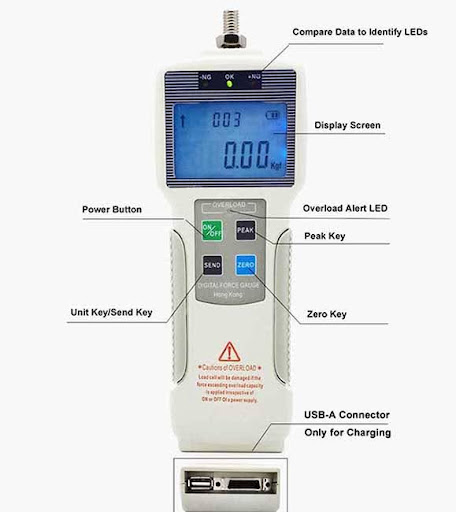In today’s fast-paced manufacturing and research environments, quality control and testing are critical for ensuring that products meet industry standards and customer expectations. One of the most reliable tools used in these processes is the digital force gauge. These precision instruments have transformed how companies measure and monitor force, ensuring accuracy, consistency, and efficiency in testing procedures.
This article explores what digital force gauges are, how they work, their applications in quality control, benefits, and best practices for using them effectively.
What Are Digital Force Gauges?
Digital force gauges are handheld or mounted instruments designed to measure push or pull forces in real-time. Unlike traditional mechanical force gauges, they display readings digitally, often in multiple units like Newtons, kilograms, or pounds, making them more user-friendly and accurate.
These devices are widely used in laboratories, production lines, and quality inspection departments for tasks such as tensile testing, compression testing, and load measurement.
Why Force Measurement Matters in Quality Control
Quality control (QC) is about ensuring that every product leaving the production line meets predetermined quality standards. Force measurement plays a crucial role because:
- Material Strength Verification – Ensuring materials can withstand intended loads without breaking.
- Product Safety Testing – Checking whether products meet regulatory requirements.
- Performance Consistency – Guaranteeing that each unit performs as expected under physical stress.
Without accurate force measurement, defective products could reach customers, leading to safety hazards, brand damage, and costly recalls.
How Digital Force Gauges Work
A digital force gauge typically consists of:
- Load Cell or Sensor – Converts applied force into an electrical signal.
- Microprocessor – Processes the signal into a readable force value.
- Digital Display – Shows precise measurements in real-time.
Some models like 0-5N digital force gauge also offer data logging capabilities, USB connectivity, and advanced analysis features for better QC documentation.
Applications of Digital Force Gauges in Quality Control
Digital force gauges are versatile and find applications across many industries:
1. Manufacturing
- Testing the durability of packaging materials.
- Checking press-fit parts in assembly lines.
- Verifying product strength before shipment.
2. Automotive Industry
- Measuring the force required to open and close doors.
- Testing spring tension in mechanical components.
- Verifying brake pedal resistance.
3. Electronics
- Checking the strength of soldered joints.
- Testing the durability of connectors and switches.
4. Medical Devices
- Ensuring medical instruments meet safety standards.
- Measuring tensile strength of sutures and other components.
5. Food and Beverage
- Testing packaging seals to prevent leaks.
- Measuring the opening force for consumer safety.
Benefits of Using Digital Force Gauges in QC
Using digital force gauges offers several advantages over mechanical alternatives:
- High Accuracy – Digital readouts reduce human error and provide consistent results.
- Multiple Measurement Units – Easily switch between Newtons, pounds, and kilograms.
- Data Storage – Record and store results for quality audits.
- Ease of Use – Intuitive interfaces and real-time results.
- Enhanced Productivity – Faster testing compared to manual tools.

Case Study: Improving QC in a Packaging Plant
A packaging manufacturer implemented digital force gauges to measure the sealing strength of its products. Previously, the company used manual spring-based gauges, which led to inconsistent results. After upgrading, they achieved:
- 30% improvement in the accuracy of readings.
- Reduction in product recalls due to defective seals.
- Better compliance with industry safety standards.
This example demonstrates how digital tools can directly impact quality outcomes and customer satisfaction.
Best Practices for Using Digital Force Gauges in QC
To maximize the benefits of digital force gauges, consider these tips:
- Regular Calibration – Keep measurements accurate by calibrating according to manufacturer guidelines.
- Proper Handling – Avoid dropping or overloading the device.
- Use the Right Accessories – Different tests require specific attachments (hooks, compression plates, grips).
- Record Data Systematically – Take advantage of built-in data logging to track results over time.
- Train Staff – Ensure operators know how to use the gauge correctly to prevent misuse and errors.
Digital Force Gauges vs Mechanical Force Gauges
While mechanical force gauges still have their place in basic applications, digital force gauges offer:
- Better accuracy due to digital sensors.
- More flexibility with measurement units.
- Data recording for traceability.
- Advanced features like peak hold, pass/fail indicators, and connectivity.
For industries focused on high-quality standards, digital models are a better investment.
The Future of Digital Force Gauges in Quality Testing
The next generation of digital force gauges is likely to include even more advanced features such as:
- AI-based defect detection.
- Cloud data integration for real-time QC monitoring.
- Wireless connectivity for IoT-enabled smart factories.
As manufacturing and quality control processes become more automated, digital force gauges will play an even greater role in ensuring product reliability.
Conclusion
In quality control and testing, digital force gauges are indispensable tools. They deliver accurate, consistent, and traceable results, critical for maintaining product integrity and safety. From packaging plants to medical device manufacturers, these instruments help ensure that only the best products reach customers.
By investing in the right digital force gauge and following best practices, businesses can enhance their QC processes, reduce product failures, and strengthen customer trust.

